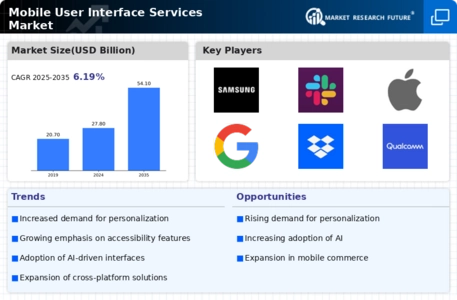Top Industry Leaders in the Mobile User Interface Services Market

Competitive Landscape of Mobile User Interface Services Market:
The mobile user interface (UI) services market is a bustling sector driven by the ever-expanding reach of smartphones and the growing importance of engaging user experiences. With billions of people interacting with apps and websites on their mobile devices, the demand for intuitive, user-friendly, and aesthetically pleasing interfaces has skyrocketed. Consequently, the competitive landscape in this market is dynamic and multifaceted, characterized by diverse players, evolving strategies, and constant innovation.
Key Players:
- Google (U.S.)
- Apple Inc. (U.S.)
- Microsoft Corporation (U.S.)
- Samsung (South Korea)
- Adobe (U.S.)
- Fujitsu Limited (Japan)
- Rossul Design (Canada)
- Qualcomm Inc. (U.S.)
- LG (South Korea)
- HTC (Taiwan)
Strategies for Differentiation and Growth:
Companies in the mobile UI services market compete fiercely for market share, employing various strategies to stand out:
- Specialization: Many players focus on specific industries or verticals, such as fintech, healthcare, or e-commerce, catering to the unique UI/UX needs of those sectors.
- Technology Integration: Integrating emerging technologies like augmented reality, chatbots, and voice interfaces helps companies offer cutting-edge UI solutions and stay ahead of the curve.
- Data-Driven Design: Utilizing user data and analytics to inform design decisions, optimize user journeys, and personalize experiences is becoming increasingly critical.
- Agile Development: Adopting agile methodologies allows for rapid prototyping, iteration, and testing, ensuring UI designs are responsive to user feedback and market trends.
- Subscription Models: Offering subscription-based UI/UX services provides recurring revenue streams and fosters long-term client relationships.
Factors for Market Share Analysis:
Analyzing market share in the mobile UI services market requires considering several key factors:
- Client Portfolio: The types and sizes of clients a company serves can indicate its reach and expertise.
- Geographic Footprint: Global presence and the ability to cater to diverse regional needs can be a competitive advantage.
- Technology Stack: Access to proprietary design tools and cutting-edge technologies can differentiate a company's offerings.
- Awards and Recognition: Industry awards and positive client testimonials build trust and attract potential customers.
- Financial Performance: Revenue growth, profitability, and investment in research and development indicate a company's market strength.
New and Emerging Players:
The mobile UI services market is constantly evolving, with new players and innovative approaches emerging:
- AI-powered design tools: Platforms like Figma and Adobe XD utilize artificial intelligence to automate repetitive tasks and suggest design improvements, making UI/UX creation more efficient and accessible.
- Remote design collaboration: Tools like InVision and Zeplin facilitate seamless collaboration between designers, developers, and clients across geographical boundaries.
- Micro-services marketplaces: Platforms like Fiverr and Upwork are expanding their offerings to include specialized UI/UX micro-services, allowing businesses to access specific design expertise on demand.
- Design communities and open-source tools: Online communities and platforms like Dribbble and Behance are fostering knowledge sharing and collaboration, contributing to the development of open-source UI/UX tools and best practices.
Current Investment Trends:
Investment in the mobile UI services market is on the rise, driven by several factors:
- Growing demand for mobile apps: The increasing reliance on mobile devices for work, entertainment, and communication fuels the need for well-designed and user-friendly apps.
- Focus on user experience (UX): Businesses are recognizing the critical role of UX in driving user engagement, brand loyalty, and ultimately, revenue.
- Integration of emerging technologies: The rise of technologies like AR, VR, and voice interfaces creates new opportunities for innovative UI design solutions, attracting investment from both established players and venture capitalists.
- Expansion of global markets: The growing mobile user base in developing regions like Asia and Africa presents significant growth potential for mobile UI services providers.
Latest Company Updates:
October 20, 2023, VentureBeat discusses the increasing integration of AI and machine learning in mobile UI design. AI-powered features like voice recognition, predictive text, and personalized recommendations are becoming commonplace, aiming to enhance user engagement and provide a more efficient experience.
November 29, 2023, The Verge reports on the growing popularity of dark mode in mobile apps and operating systems. Dark mode not only offers a visually appealing alternative but also addresses concerns about eye strain and battery consumption.
December 14, 2023, TechRadar explores the potential of augmented reality (AR) and virtual reality (VR) in transforming mobile UI design. These technologies offer immersive and interactive experiences that could revolutionize how users interact with their devices.









